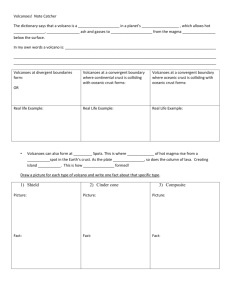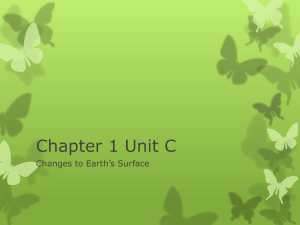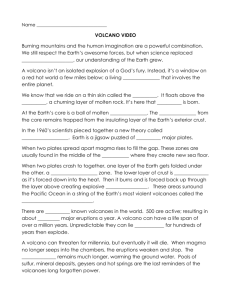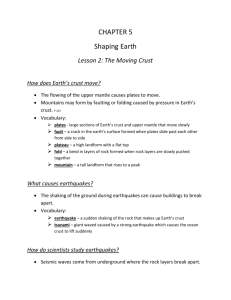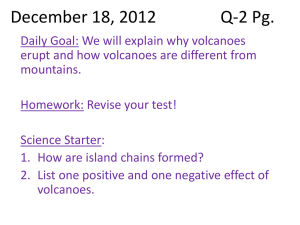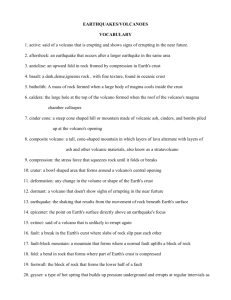Chapter 5 Test
advertisement
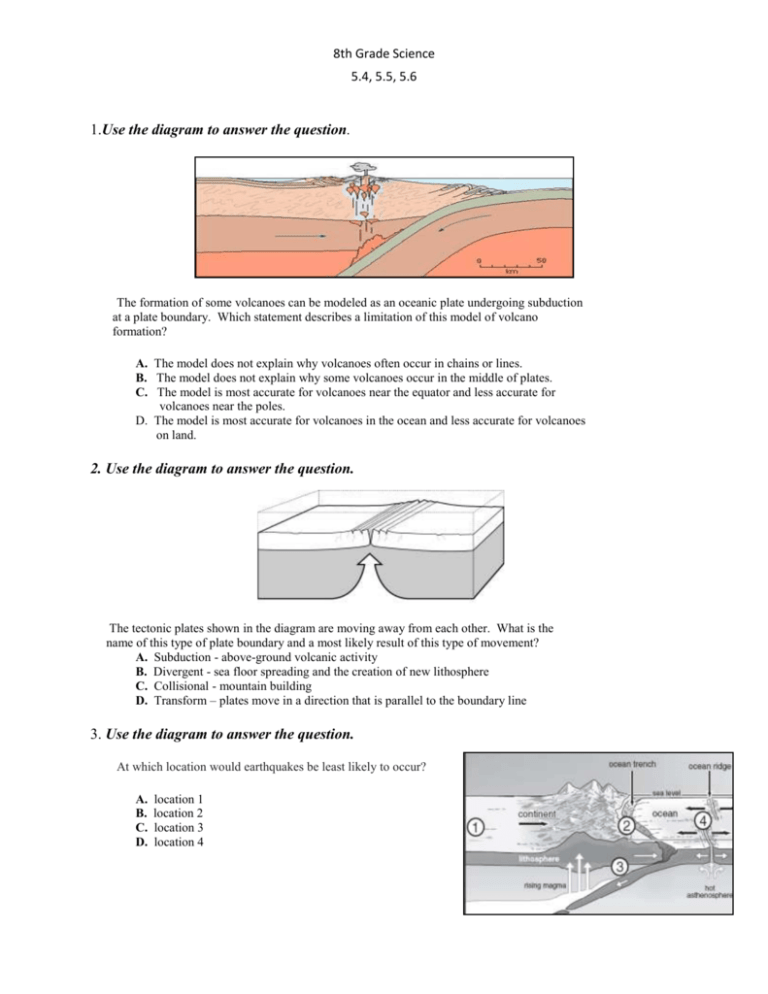
8th Grade Science 5.4, 5.5, 5.6 1.Use the diagram to answer the question. The formation of some volcanoes can be modeled as an oceanic plate undergoing subduction at a plate boundary. Which statement describes a limitation of this model of volcano formation? A. The model does not explain why volcanoes often occur in chains or lines. B. The model does not explain why some volcanoes occur in the middle of plates. C. The model is most accurate for volcanoes near the equator and less accurate for volcanoes near the poles. D. The model is most accurate for volcanoes in the ocean and less accurate for volcanoes on land. 2. Use the diagram to answer the question. The tectonic plates shown in the diagram are moving away from each other. What is the name of this type of plate boundary and a most likely result of this type of movement? A. Subduction - above-ground volcanic activity B. Divergent - sea floor spreading and the creation of new lithosphere C. Collisional - mountain building D. Transform – plates move in a direction that is parallel to the boundary line 3. Use the diagram to answer the question. At which location would earthquakes be least likely to occur? A. B. C. D. location 1 location 2 location 3 location 4 8th Grade Science 5.4, 5.5, 5.6 B A 4. Use the diagram to answer the question. Tension, compression, and shearing work over millions of years to change the shape and volume of rock. Choose the answer that correctly identifies these 3 types of stress that can occur in Earth’s crust. A. B. C. D. C A-compression, B-tension, C-shearing A-tension, B-compression, C-shearing A-shearing, B-compression, C-tension A-shearing, B-tension, C-compression 5. Which force squeezes Earth’s crust to make the crust shorter and thicker? A. tension B. normal C. shearing D. compression 6. At what point does magma become lava? A. below a vent C. at Earth’s surface B. inside a pipe D. in Earth’s mantle 7. Where are areas that are at greatest risk of earthquakes? A. in the center of plates C. in the middle of the ocean B. where plates meet D. where land meets water 8. The stress force that pulls on the crust and thins rock in the middle is A. shearing B. compression C. tension D. uplifting 9. The stress force that squeezes rock until it folds or breaks is A. shearing B. compression C. tension D. uplifting 10. A fault in which the rocks on either side of the fault move sideways past each other is a A. slip-strike fault C. hanging fault 11. Compression causes the formation of A. only anticlines C. Both anticlines and synclines B. normal fault D. reverse fault B. only synclines D. neither anticlines or synclines 12.Which of the following is an opening through which molten rock and gas leave a volcano? A. pipe B. magma chamber C. crater D. vent 13. A volcano erupts quietly if its magma is which of the following? A. cool B. solid C. low in silica D. high is silica 14. What do geologists call a volcano that is not likely to erupt ever again? A. extinct B. dormant C. sleeping D. active Fill in the blank to complete each statement. 15. Stress is a(n) ________________________ that acts on rock to change its shape or volume. 8th Grade Science 5.4, 5.5, 5.6 16. The collision of two plates causes the formation of ____________________________ mountains. 17. When two plates move away from each other _____________________________ faults are created. 18. A fold in rock that bends upward into an arch is a(n) _________________________. 19. A fold in rock that bends downward is a(n) ___________________________. 20. An area where material from deep within Earth’s mantle rises to the crust and melts to form magma is called a(n) __________________________. 21. ______________________________ is an underground molten mixture of rock-forming substances, gases, an d water from the mantle. 22. Volcanic belts form along the boundaries of Earth’s _________________________. 23. A volcano is a(n) ____________________________ that forms in Earth’s crust when molten material reaches the surface. 24. The Ring of Fire is a major belt of ___________________________________. 25. Geologists say a volcano is ______________________ if it is expected to awaken in the future. 26. A mixture of hot gases, ash, cinders, and bombs that erupt explosively are called a(n) ___________________________ flow. 27. Geologists classify volcanic eruptions as quiet or ________________________________. 28. A(n) ____________ ______________________ is a pocket of magma beneath the surface. Label the parts of the volcano. 29. ______________ 30. ______________ 31. ______________ 32. ______________ 33. ______________ 34. ______________ 35. ______________
